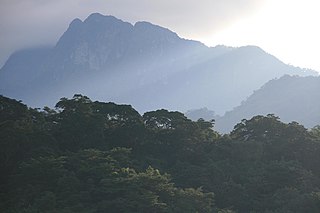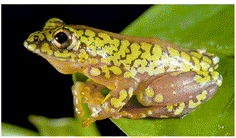
A partridge is a medium-sized galliform bird in any of several genera, with a wide native distribution throughout parts of Europe, Asia and Africa. Several species have been introduced to the Americas. They are sometimes grouped in the Perdicinae subfamily of the Phasianidae. However, molecular research suggests that partridges are not a distinct taxon within the family Phasianidae, but that some species are closer to the pheasants, while others are closer to the junglefowl.

The Zanzibar bushbaby, Matundu dwarf galago, Udzungwa bushbaby, or Zanzibar galago is a primate of the family Galagidae. An adult typically weighs 150 grams (5.3 oz), its head-body length is 14 to 15 centimetres and its tail is between 12 and 15 centimetres long. Like other species of galagos, its diet consists mainly of fruit, insects, and tree gums.

The Udzungwa Mountains are a mountain range in south-central Tanzania. The mountains are mostly within Iringa Region, south of Tanzania's capital Dodoma. The Udzungwa Mountains are part of the Eastern Arc Mountains, and are home to a biodiverse community of flora and fauna with large numbers of endemic species.
The Udzungwa forest partridge, also known as the Udzungwa partridge, is a small, approximately 29 centimetres (11 in) long, boldly barred, brownish partridge with rufous face, grey underparts, olive-brown crown and upperparts. It has a red bill, brown iris and yellow legs. Both sexes are similar.
The Uluguru mountains are a mountain range in eastern Tanzania, named after the Luguru tribe. The main portion of the Uluguru mountains is a ridge running roughly north-south and rising to 2,630 metres (8,600 ft) altitude at its highest point. On the main Uluguru range, 50 villages touch the forest boundary and over 151,000 people are found within the mountain area, often at increasing densities at higher altitudes up to the forest boundary.

The Eastern Arc Mountains are a chain of mountains found in Kenya and Tanzania. The chain runs from northeast to southwest, with the Taita Hills being in Kenya and the other ranges being in Tanzania. They are delimited on the southwest by the fault complex represented by the Makambako Gap that separates them from the Kipengere Range. To the northeast, they are delimited by more recent volcanism represented by Mount Kilimanjaro. The chain is considered a tentative World Heritage Site.
Winifred's warbler, also known as Mrs. Moreau's warbler, is a species of bird in the family Cisticolidae. The species was first recorded and named by the ornithologist Reginald Moreau after his wife.

Hyperolius minutissimus is a species of frog in the family Hyperoliidae. It's common names are tiny reed frog and dwarf reed frog. It is endemic to Tanzania and known from the Udzungwa Mountains and from near Njombe in the Southern Highlands.

Rhynchocyon is a genus of elephant shrew in the family Macroscelididae. Members of this genus are known colloquially as the checkered elephant shrews or giant sengis. It contains the following five species:
Scepomycter is a genus of threatened birds in the family Cisticolidae. The two species are endemic to highland forests in the Eastern Arc Mountains of Tanzania. They are small, mainly grey birds with a reddish-orange head.
The Rubeho forest partridge is a small, approximately 29 centimetres (11 in) long, boldly barred, brownish partridge with rufous face, grey underparts, and olive-brown crown and upperparts. It has a red bill, brown iris, and yellow legs. Both sexes are similar.

The grey-faced sengi is a species of elephant shrew that is endemic to the Udzungwa Mountains of south-central Tanzania. The discovery of the species was announced in January 2008; only 15 species of elephant shrew were known until then, and the last discovery was made more than 120 years ago. As the name implies, the species is characterised by a distinctive grey face and a black rump, as well as being larger than the other species of elephant shrews.
Mikumi National Park is a national park near Morogoro, Tanzania with an area of 3,230 km2 (1,250 sq mi) that was established in 1964. It is the fourth largest in the country. The park is crossed by Tanzania's A-7 highway.
The Rubeho warbler is a threatened species of bird in the family Cisticolidae. It is found in highland forests in the Rubeho–Ukaguru Mountains in Tanzania. This cryptic species was only described in 2009; it having traditionally been included in the closely related Winifred's warbler.

Perdicinae is a polyphyletic former subfamily of birds in the pheasant family, Phasianidae, regrouping the partridges, Old World quails, and francolins. Although this subfamily was considered monophyletic and separated from the pheasants, tragopans, junglefowls, and peafowls (Phasianinae) till the early 1990s, molecular phylogenies have shown that these two subfamilies actually constitute only one lineage. For example, some partridges are more closely affiliated to pheasants, whereas Old World quails and partridges from the Alectoris genus are closer to junglefowls. Due to this, the subfamily Perdicinae is no longer recognized by the International Ornithological Congress, with the species being split among 3 subfamilies.

The Eastern Arc forests is a montane tropical moist forest ecoregion of eastern Africa. The ecoregion comprises several separate highland areas above 800 meters in Kenya, and (mostly) Tanzania.

The eastern tree hyrax is a species of mammal within the family Procaviidae. The eastern tree hyrax is the most localized of the tree hyrax species, distributed patchily in a narrow band of lowland and montane forests in Kenya and Tanzania and adjacent islands.
The Rubeho Mountains are a mountain range in central Tanzania. The mountains in Dodoma and Morogoro regions, southeast of Tanzania's capital Dodoma. The Rubeho Mountains are part of the Eastern Arc Mountains, and are home to a biodiverse community of flora and fauna with large numbers of endemic species.
Jon Fjeldså is a Norwegian-born Danish ornithologist and bird artist. Fjeldså has authored several books and published numerous research papers, primarily focusing on grebes, birds of the Andes and Eastern Arc Mountains, and evolution of passerines. He is an emeritus professor at the University of Copenhagen.
Dinesen, L., Lehmberg, T., Svendsen, J.O., Hansen, L.A., Fjeldså, J. 1994. A new genus and species of perdicine bird (Phasianidae, Perdicini) from Tanzania; a relict form with Indo-Malayan affinities. Ibis 136: 2-11.











